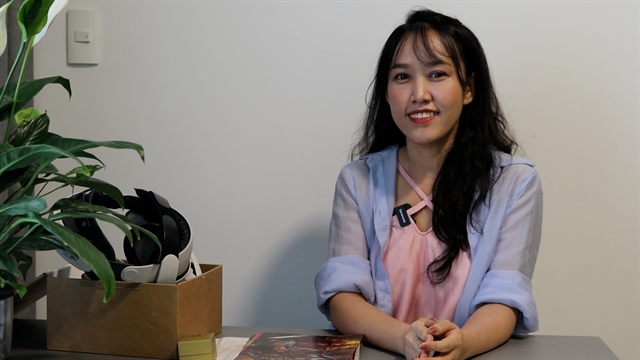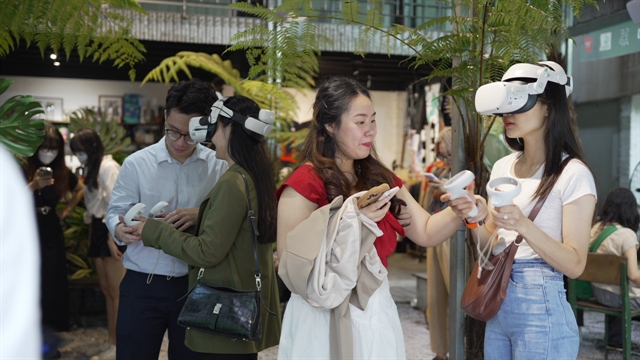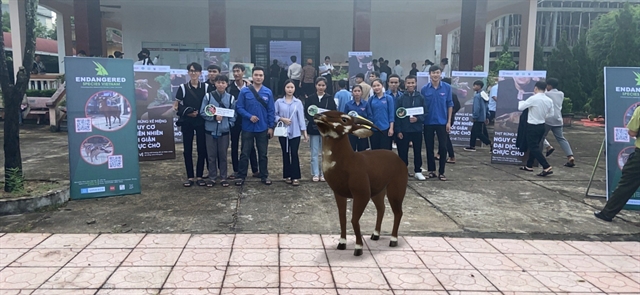Besides canvases and paint brushes, virtual reality (VR) has been Đặng Thị Minh Hằng’s means of creativity. Not only does the technology enable her to create exceptional artworks, it is also one of the mediums she uses in her project "Endangered" to spread awareness of wildlife conservation. Gia Linh speaks with the aspiring artist on her journey.

Đặng Thị Minh Hằng, a virtual reality artist in HCM City, has applied extended reality to help conserve wild animals through her project 'Endangered'. VNS Photo Gia Linh
Inner Sanctum: Can you please tell us about yourself?
I'm Đặng Thị Minh Hằng, and I've been a self-taught virtual reality artist for over two years. I'm the founder of a wildlife conservation project named "Endangered" that applies extended reality (XR) to promote wildlife conservation.
Inner Sanctum: Can you tell our readers about your art journey? What are the reasons behind your sudden change in art style?
I started learning art when I was around seven, and my love for art has continued since. Since I have received a number of awards, I believe I can thrive in this industry.
After graduating from university, I began working as a comic book and game artist. Things started to take a turn when I had my first child. I realised that I didn’t want her to see my drawings of such violent scenes in games and comic books, and so I considered other options. After experimenting with various materials, I chose VR art since I was interested in it earlier, and it is the most suitable for me.
Inner Sanctum: VR art is still new to some of our readers, so can you explain the difference between it and other art forms?
VR is a subsidiary of Extended Reality (XR). There are also other subsidiaries such as Augmented Reality (AR), and Mixed Reality (MR).
While a VR environment is completely virtual, an MR one is a combination of objects from both the real and virtual world. Then for AR, it is when a virtual object is placed in a real environment, such as the animals that I created for my Endangered project.
I think the key point of VR art lies in the immersive experience it brings. With only a VR headset and two controllers, an artist can maximise their creativity by drawing in a complete three-dimensional space and using various tools that transcend physical boundaries. They can ultimately focus on their work and express themselves best.
VR art also provides viewers with a wholly mesmerising experience when seeing pictures. They are able to step inside a painting and be a part of it rather than looking at it from afar.
Inner Sanctum: Please tell us more about the conservation project you mention. What are some sub-projects that you have done? What role can virtual reality play in protecting wildlife and the environment?
I was the winner of the UNESCO NewView XR Field Lab (Mekong area) last year, and Endangered was founded following the event with the aim of using XR in conserving wild animals.
My first-ever project was the XR: Endangered Species Vietnam 2023 in HCM City, an immersive exhibition that raised funds for conserving biodiversity in Đắk Lắk Province’s Chư Yang Sin National Park.
At the event the audience could interact with two virtual animals, a spindlehorn and a meerkat, and participate in reviving a virtual dead forest by drawing green leaves, trees and other animals in it.

Hằng hosted an immersive exhibition in HCM City last year to apprise the public about virtual reality art and raise awareness of protecting wildlife biodiversity. Photo courtesy of Đặng Thị Minh Hằng
It attracted 348 visitors, and they paid whatever they wanted for their tickets. We were able to raise over VNĐ13 million (US$500).
By applying XR to the exhibition, I wanted to minimise the use of natural and man-made materials. I was able to provide participants with an immersive experience while protecting the environment and limiting unnecessary costs on materials.
My virtual animals also appeared in the Thịt Rừng Kề Miệng, Nguy Cơ Chực Chờ (Wild Meat Consumption - a Source of Infectious Diseases) campaign launched by the World Wildlife Fund in Quảng Trị Province. It is to spread awareness on the risks of wild meat consumption to public health and nature.

A spindlehorn is among the virtual animals to appear in Hằng’s 'Thịt Rừng Kề Miệng, Nguy Cơ Chực Chờ' (Wild Meat Consumption - a Source of Infectious Diseases) campaign in Quảng Trị Province. Photo courtesy of Đặng Thị Minh Hằng
I was honoured to participate in a talk show at the Nam Cát Tiên National Park (Đồng Nai Province) in January, about the IUCN Green List, a global campaign offering locally relevant expert guidance for successful nature conservation in protected and conserved areas.
Inner Sanctum: What are the challenges you have faced while working with this form of art in your project?
When creating a VR painting, I have to simultaneously run multiple applications and devices. Because this technology is in its developmental stage, there will always be glitches and crashes.
Besides, as I have little experience in organising such large events, knowing how to smoothly showcase the technology to the public and connect with other co-organisers were a bit challenging for me. But the projects were successful thanks to my amazing partners such as XR Zoo, SEAP VR and HAT ARTS, to name a few.
Inner Sanctum: What are your future plans? Do you have any upcoming projects?
I want to expand the scope of my project by connecting with more like-minded individuals and localities. If possible, I want to have QR codes placed in every province and city showing virtual pictures of local animals and plants that are on the verge of extinction. I believe this will help raise awareness among local people of protecting endangered species and could also encourage people in these areas to donate to conservation projects. VNS
OVietnam